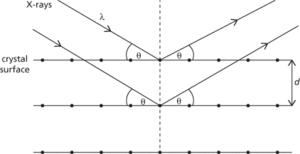When a beam of X-rays (wavelength λ) strikes a crystal surface in which the layers of atoms or ions are separated by a distance d, the maximum intensity of the reflected ray occurs when sinθ=nλ/2d, where θ (known as the Bragg angle) is the complement of the angle of incidence and n is an integer. The law enables the structure of many crystals to be determined. It was discovered in 1912 by Sir Lawrence Bragg. Bragg’s law has also been applied to diffraction in an optical lattice, i.e. it can be applied to atoms owing to the wave nature of atoms.

Bragg’s law.
When a beam of X-rays (wavelength λ) strikes a crystal surface in which the layers of atoms or ions are separated by a distance d, the maximum intensity of the reflected ray occurs when sinθ = nλ/2d, where θ (known as the Bragg angle) is the complement of the angle of incidence and n is an integer. The law enables the structure of many crystals to be determined. It was discovered in 1912 by Sir William Lawrence Bragg.
In crystallography, the law that describes how an X-ray beam is reflected or diffracted in a crystal lattice, given by the Bragg equation nλ – 2dsinϴ where n is any integer, λ is the wavelength of the incident-beam X-ray, d is the spacing between crystal planes (d spacing), and ϴ is the angle between the crystal plane and the diffracted beam (the Bragg angle). Used in X-ray diffraction for the identification of minerals.
- sunk costs
- Sun Microsystems Inc.
- Sunni
- sunrise
- sunseeker
- Sun sensor
- sunset
- sunshade
- sunshine recorder
- sunskirter
- sunspot
- sunspot cycle
- sunspot number
- sunspot theory
- Sun-synchronous orbit
- sun-tan age
- Sun Tsu
- Sunyaev–Zel'dovich effect
- sunyata
- Sun Yat-sen (1866–1925)
- Sunzi
- Suomi NPP
- sup
- super-
- superacid